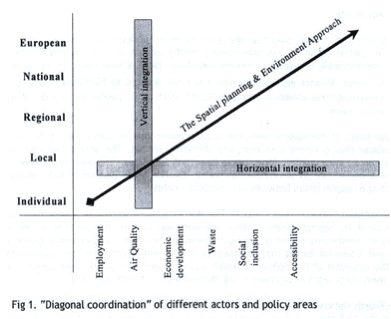4. The National Planning Framework should not be a crude summary of existing national guidance as is currently proposed. Whilst existing guidance is undoubtedly too verbose and unwieldy, there is a need for NPF and policy guidance statements to co-exist in a virtuous circle. These can and should be written in plain English and made accessible to all public(s). The importance of taking a spatial planning approach cannot be overstated (see Figure 1) learning the lessons from experiences in both Wales and Scotland. It seems a missed opportunity to neglect what our relations the over side of the border have learnt through their spatial plans. My own view is that the NPF for Scotland is an important and useful process. Please note I use the word ‘process’ specifically because the framework was an iterative process of stakeholder consultation, engagement and review leading to an outcome.
5. Without some degree of spatial thinking and direction, it will be difficult to make the connection with planning at the sub-regional, local and neighbourhood levels and to interpret clearly what the Government is saying. For example, the Government stresses the importance of increasing the supply of housing nationally, but how and where in particular? Such growth areas must surely be identified in the national interest. Crucially, however, the government need to provide a spatial plan and vision which still can endorse the principles of a locally shaped planning system but alerting people to
a. Major infrastructure developments including road and rail that will operate at national/international scales
b. Large scale developments or protected areas which are serving the national interest
c. Major growth areas for investment (link in with European funding)
6. The experience of the EU is important here. Their spatial planning approach is based on polycentric development. So rather than focus on core development areas (the London/Paris/Berlin ‘banana’) the approach/policy spreads the benefits out across the whole EU (grapes). Such a spatial strategy needs discussion, modification and application to the English context, but in many ways a spatial strategy based on possible ingredients in a fruit bowl would be easy for the public to visualise and comment on!!! This is important given the widespread perception that growth, investment and housing is too heavily focused on the South East for example.
7. The NPF must have a vision and spatial component and signal where the nation’s big investments and big ideas are going to be pitched. HS2 is a classic case in point; it should not be suddenly thrust on to the stage otherwise it will throw into chaos existing plans as evidenced by the planning blight on a route that has yet to satisfy the EA directive.
8. The NPF/spatial plan process can, and should be inclusive, so it is not about Whitehall imposing its own view. It is about people and communities participating in a debate, thinking in the national interest about the kind of England we want. All too often people and politicians don’t or don’t want to. Indeed, the localism agenda poses a further risk of people only thinking of their own local concerns without making wider connections to societal interests which, in my view is what good planning is all about. The lack of national spatial plan is a major impediment to strategic planning which will be the driver of our economic recovery. The current vacuum is extremely dangerous and will not be solved by a summary of existing PPS!
9. There is a need to connect across the vertical scales of planning from Global to European- national – regional – local – neighbourhood- individual within a framework that :
a. Explains how the planning system works and where and how people and publics can get involved to shape it. This will prevent problems with the public bypassing their vital involvement in development plans in favour of the more populist but restricted neighbourhood plans .
b. Highlights our international and domestic legal obligations for how we should plan our spaces and develop our plans. Eg. Kyoto, SEA, Natura 2000, Water Framework Directive. At present these requirements are neglected in the localism rhetoric.
c. Understands the way the SEA directive influences our NPF. All plans and policies including neighbourhood plans will require SEA. The NPF must set out how the new planning system will actually work.
d. There has been little comment on how our own domestic legislation or regulations which stem from European Directives apply. This is vital in order to allow people to understand the legal obligations they have in discharging or shaping components of the new planning system, otherwise plans/people may face judicial reviews. The case of Habitat Regulations Assessments for example has caught many professional planners out.
10. There is a need to connect across the different sectoral interests in creating improved local development plans which endorse an inclusive approach. At present the planners need to better develop the concept of ownership in development plans that should be co-produced across the different sectors. National Guidance needs to promote real partnership approaches as part of a new NPF ensuring that all players are able to shape new policy and plans. At present I observe too many people throwing brick bats at planners without properly participating in the processes by which we should improve our places and spaces for maximum societal benefit.
11. National guidance needs to recognise the invaluable role that planning and planners play and the way to improve public involvement. The present rhetoric approach merely portrays planners as restrictors of growth which is perverse and inaccurate and is leading to damaging effects on the status and morale of those engaged in planning.
a. At present there is a risk that the highly promoted neighbourhood plans will divert local people from participating in local development plans (or whatever new name is given) which are actually the blueprints for the neighbourhood plans (i.e. neighbourhood plans must be in conformity with local plans). This potential disjuncture could lead to considerable conflict between local authorities and communities.
b. The NPF must clearly set out the dependencies showing that public involvement in shaping the local development plan is key as this will shape the boundaries within which the neighbourhood plans operate.
c. The NPF should elevate the profile and importance of community strategies. Parish plans are not omnipresent but community strategies are a key document that are supposed to prioritise the needs of communities and serve as the basis for long term planning. If there was greater investment in these processes. At present this is very poor; there would be a much better evidence base for planning and other policy development. .
12. The planning system is about delivering sustainable development. The NPF must provide the criteria within which SD will be assessed. There is a need for a much clearer and assessable definition of sustainable development from the government which should guide all planning activity and decision making. At present SD can be easily hijacked and manipulated by interests, so much so that the very term is devalued and made almost meaningless. Criteria upon which SD credentials are measured (in whatever way people want) are urgently required and will help achieve the transparency and consistency that some planning decisions currently lack. Crucially all developments should adhere to a development plan which must be the prime statutory basis for decisions.
We should not move away from a plan-led system to allow a case by case assessment.
For example the following criteria are suggested;
a. Be in accordance with the development plan
b. Achieve a significant reduction (locally derived) in carbon and ecological footprints
c. Based on accurate assessments of economic, social and environmental needs and costs
d. Demonstrate a positive social impact addressing equity and social justice in decision making
e. Include all potential publics in processes of consultation, participation and decision making
f. Consider the long term implications and management of decisions
13. Finally planning is about visions. We need to put the visions back into planning and the NPF should lead by example.



























